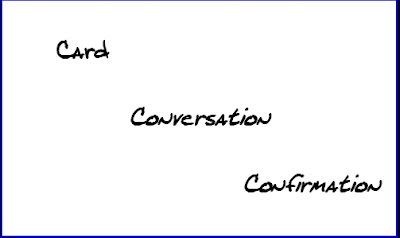
Source:
Too often, the story card is the thing that agile teams elevate. Some teams insist on strict verbiage for what gets written on the card, or on writing the stories very neatly (sometimes even printing them), or on strictly arranging cards on a peg board and adding rules about who can touch the cards and move them. Some teams even go as far as to spend hundreds of thousands of dollars on a tool to track the cards.
But they're only cards! The card is perhaps one of the least important things in agile software development. Wow, that seems like an odd statement for me to make--this whole Agile in a Flash project is about the power of index cards. I carry cards with me at all times. I often depend on their power and flexibility to help expedite various meetings (planning, estimating, brainstorming, etc.). The cards are a very useful tool, but they aren't what's important. The cards ain't the thing!
- Card - Index cards are little physical things on which you can jot only a few things. A card does not capture all details about what should be built. It is instead a reminder, a promise for subsequent communication that must take place. Ron refers to the card as a "token," a word choice that I like a lot: The card isn't the thing--it's a placeholder for the real thing.
- Conversation - So what is the real thing? Collaborating to build and deliver software that meets the customer's needs! To succeed, we must converse continually. We must continue to negotiate supporting specifics for a story until all parties are in agreement and the software is delivered.
- Confirmation - The specifics of what we're building must ultimately be clear to the customer and the team who will deliver. The customer captures this criteria in acceptance tests, designed to exercise the system in enough ways to demonstrate that the feature really works. When this set of acceptance tests for a given card all pass, it confirms to the customer that the story is truly done--the software does what they asked.
I think you could run a very successful agile project without using a single index card. But that's not what I'm recommending. The key thing is to understand what the cards represent.
No comments:
Post a Comment
Note: Only a member of this blog may post a comment.